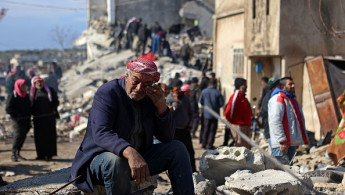Five MENA countries among top 10 'most miserable' in economy-based index
Five countries in the Middle East and North Africa region have ranked among the top 10 most miserable nations in the world, according to an index released last week.
The 'Hanke's 2022 Annual Misery Index', created by Steve Hanke, a professor of applied economics at Johns Hopkins University in the US, is based on countries' economic performance and the socioeconomic conditions of their populations.
Conflict-ridden Syria, Sudan, Yemen, as well as crisis-hit Lebanon were among the countries listed in the top 10 of the index, owing mainly to unemployment and inflation. Turkey also ranked very highly, bookending the top 10.
The index lists each country's unemployment and inflation rates, the real GDP per capita growth, among other statistics.
|
Sources include the Economist Intelligence Unit, the International Monetary Fund, the World Bank, and other institutions, according to Hanke.
The major contributing factor behind Syria’s ranking was unemployment, while for Lebanon, Sudan, Turkey and Yemen it was inflation.
Years of war have ravaged both Syria and Yemen’s economies and infrastructure, displacing millions and killing hundreds of thousands of people in total. A massive earthquake that struck southeast Turkey and northwest Syria on 6 February exacerbated the already desperate situation for millions of Syrians.
Syria ranked third on the list while Yemen ranked seventh.
Sudan, which has suffered political instability for years, was also plunged into fighting last month between rival military factions, further damaging its already battered economy. It ranked fifth on the list.
Egypt's currency crisis is killing young people's dreams
— The New Arab (@The_NewArab) January 27, 2023
✍ @lar_gibson https://t.co/CgH25m9b9v
Lebanon is in the midst of one of the world’s worst financial crises since at least the mid-19th century, the World Bank has said.
The small Eastern Mediterranean nation of around 6 million has reeled under its worst-ever economic crisis due to decades of gross mismanagement, rampant corruption, and other factors. It has seen triple-digit inflation, while the local currency has surpassed 100,000 Lebanese pounds against the dollar.
The crisis has locked people out of their bank savings, plunged hundreds of thousands into poverty, and has pushed the state’s electricity and public sectors to the brink of collapse.
Structural and financial reforms have been hampered by the ruling elite, accused of embezzling and squandering public funds.
Lebanon ranked fourth on the list.
Turkey's election: Economics, the earthquake, and anti-refugee rhetoric
— The New Arab (@The_NewArab) May 11, 2023
✍ @AlessandraBajec https://t.co/BsCFZCYYwH
Turkey - currently in the grips of the most important general election in its modern history - has also seen its currency tumble and inflation soar, creating a cost of living crisis for much of its nearly 84 million people.
President Recep Tayyip Erdogan has prioritised growth, investments, and exports by cutting interest rates and stabilising the lira currency via regulations and foreign reserves.
The heavy-handed approach sent foreign investors fleeing in recent years, and the economy is set to witness more volatility even after the election is over.
The devastating 7.8-magnitude earthquake in February, the epicentre of which was near the southern Turkish city of Gaziantep, also brought further damage to the Turkish economy and the livelihoods of millions.
Atop Hanke’s misery index was Zimbabwe, while Venezuela came second, with inflation a primary factor in both rankings.
Several other MENA countries also featured high up the index. Algeria, Iraq, Iran, Jordan, Libya and Tunisia all ranked within the top 50.
Argentina, war-torn Ukraine, and Cuba were also in the top 10, while Sri Lanka, Haiti, Angola, Tonga, and Ghana ranked between 11th and 15th place, respectively.






 Follow the Middle East's top stories in English at The New Arab on Google News
Follow the Middle East's top stories in English at The New Arab on Google News


